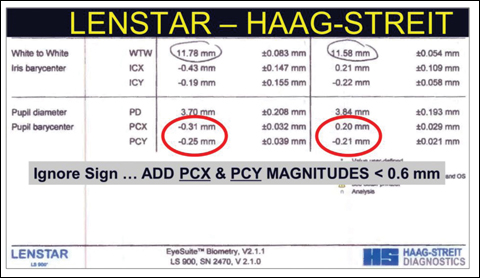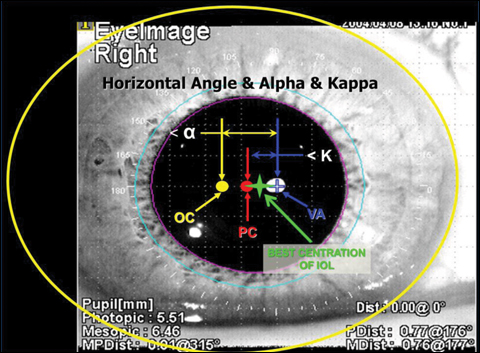Multifocal IOLs: Patient selection and optical performance
Success relies on the patient's personality, occupation, corneal quality and macular function, as well as angle kappa, corneal wavefront measures.
Multifocal IOLs have slightly less than 5% of the market in the U.S., which has been constant for the past 5 years. Yet, there are practices that implant in excess of 90% of their cataract surgery patients with multifocal IOLs. How is this disparity possible?
In this article we will discuss objective and subjective patient selection criteria as well as the optical performance of multifocal IOLs.
In successful practices with high conversions to multifocal IOLs, the staff assesses the patient’s suitability for a multifocal IOL, from the front desk and ophthalmic assistant to the insurance interview and surgeon. The staff spends more time with the patient and is usually very good at giving a rating that is useful to the surgeon during his discussion of IOL options. A questionnaire developed by Steven Dell, MD, is also helpful in assessing a patient’s needs and how the patient rates himself on a scale from “easygoing” to “perfectionist.”
Multifocal IOLs have approximately a 30% loss of contrast sensitivity (0.2 log units or 2 dB) and a decrease of slightly less than one line of best corrected visual acuity (0.1 logMAR), which is usually from 20/16 to 20/20. This slight decrease in optical performance is minimal and rarely clinically significant; it is the presence of halos and glare at night or low light levels that can cause a problem. If these “observations” (not “symptoms”) are tolerable, then the patient will be a success. The only treatment for an unhappy patient is lens exchange, and most surgeons consider this catastrophic, hence the low market share. Identifying the successful patient correctly is by far the most important factor with these IOLs.
There are occupations that make multifocals inadvisable — airline pilots, truck drivers, taxi drivers, astronomers and anyone whose job requires activity at night or low-light conditions. These people are not good candidates for multifocal IOLs because they are continually reminded of the halos and glare and have difficulty performing their jobs.

Images: Holladay JT



There are two objective measurements in which multifocals are not recommended: 1) a large positive angle (now chord ) and 2) poor higher-order root-mean-square (HO RMS) corneal wavefront error over a 6-mm zone. Chord is reported on the Lenstar (Haag-Streit) in Figure 1 and the IOLMaster (Carl Zeiss Meditec) in Figure 2. The light reflex — Purkinje 1 or visual axis (VA) — is nominally approximately 0.3 mm nasal to pupillary center (PC). Chord is the value to be evaluated and is the diagonal (hypotenuse) or square root of the sum of the squares of the x and y values (Pythagorean theorem). However, the sum of the magnitudes (ignore the sign) of x and y values is a “close enough” approximation.
The location of an IOL is ideal when it is centered on the visual axis and pupil, which is not possible unless chord is zero. This is extremely rare but occurs when the light reflex is dead center in the pupil. The next best or optimal centration for a non-zero angle for any IOL is for its center to be between PC and VA, as shown in Figure 3. This location is easy to see with a diffractive IOL because it is the location of the center of the diffractive rings. For the IOL to be in this location, it must be nasally decentered in the bag because the bag is centered on the optical axis. For the nominal values, the IOL would be 0.15 mm nasally decentered relative to the pupil (one-half chord ) and 0.45 mm nasally decentered in the bag (0.60 minus 0.15). The surgical technique to achieve this nasal location requires nudging the haptics so they are closer together nasally in the bag fornix than temporally. Simply pushing the optic nasally is temporary with self-centering IOLs.
Optimal centration between PC and VA is an optical compromise. Two articles have found that if chord is large (greater than 0.6 mm), a high percentage of subjective complaints occur from halos and glare even with proper centration of a diffractive multifocal IOL. This is because the optimal centration between PC and VA is associated with an increase in halos and glare the greater chord .
The optical quality of the cornea is also a factor. A study by McCormick in 2005 in Ophthalmology showed the average HO RMS wavefront error for a normal virgin cornea was 0.38 ± 0.14 µm over a 6-mm zone. (Tomography example in Figure 4 is 0.30 µm.) The average magnitude of an asymptomatic successful postoperative conventional LASIK cornea was 0.58 ± 0.21 µm, and the average of symptomatic patients was 1.31 ± 0.58 µm. The average age was 44 years (range: 24 to 64 years). The contribution of the crystalline lens in this age group would be negligible and similar to a monofocal IOL.
The additional loss in optical performance from the multifocal IOL suggests that patients with HO RMS corneal wavefront errors over a 6-mm zone above 0.50 µm are not a good candidates for a diffractive multifocal IOL regardless of the cause of their poor corneal optical quality (post-refractive surgery, penetrating keratoplasty, keratoconus, irregular astigmatism, etc.). The only exception is dry eye, which if successfully treated will show an improvement of the HO RMS corneal wavefront error to below 0.50 µm.
Another medical condition ill-advised for a multifocal IOL is macular degeneration. When low vision aids are needed, the reduced contrast and loss of resolution from the multifocal IOL are detrimental and make reading even more difficult.
Proper patient selection based on personality assessment, occupational needs, corneal quality and macular function along with objective optical measures of angle and corneal wavefront can almost assure success with multifocal IOLs.
Click here for the Cataract and Refractive Lens Exchange Questionnaire.
- Reference:
- McCormick GJ, et al. Ophthalmology. 2005;doi:10.1016/j.ophtha.2005.04.022.
- For more information:
- Jack T. Holladay, MD, MSEE, FACS, is a clinical professor of ophthalmology at Baylor College of Medicine and the OSN Optics Section Editor. If you have any clinical optics questions, please send them to holladay@docholladay.com. Previous articles in the Clinical Optics 101 series may be found at http://www.healio.com/ClinicalOptics101.
Disclosure: Holladay is a consultant to Abbott Medical Optics, AcuFocus, Alcon Laboratories, ArcScan, Calhoun Vision, Carl Zeiss, Elenza, Oculus and Visiometrics.
